MARY MAGDALENE Earliest writings
From an historical point of view, little has been written about Mary Magdalene. The Bible tells us much, and then leaves us with the paradox; after the Resurrection this most important disciple of Jesus is never mentioned. Many people think references to her were deliberately edited out.
The Gnostic Gospels mention her as a major disciple and a close personal friend, if not wife or lover, of Jesus, but these gospels, written in the second and third centuries, were not known to history as they were only discovered at Nag Hammedi in 1945. (They had been hidden in the 4th century by monks who refused to accept that they were heretical.)
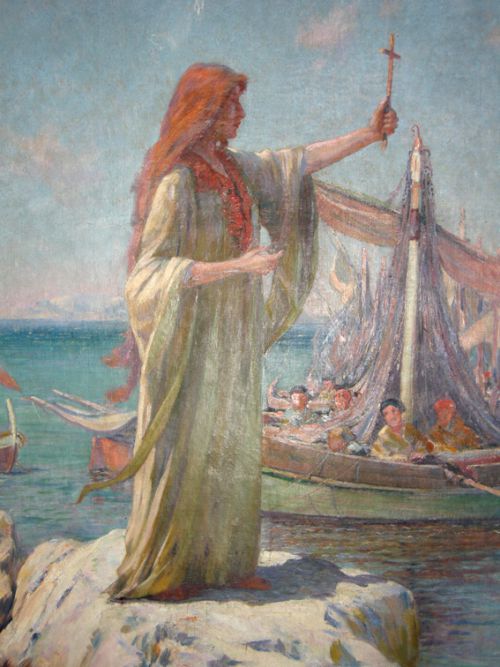 Mary Magdalene arriving in Provence.
Mary Magdalene arriving in Provence.
Official Roman church history tells us that there is no mention in history of the "traditions" of the Provençal saints, of which Mary Magdalene was one, before the 13th century. But in the 5th century (before the year 600AD) and the 8th century (before the year 900AD) stories about the life of Mary Magdalene, written by clerics, were circulating. Legends often contain a grain of truth; it does seem that Mary Magdalene came to the south of France and this was known history by the year 600AD. 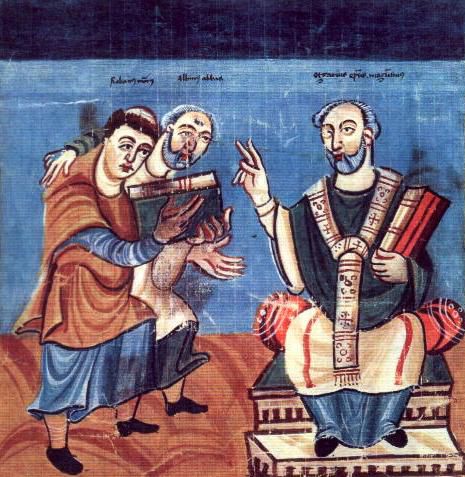 Raban Maur with Alcuin the Yorkshireman on the left
Raban Maur with Alcuin the Yorkshireman on the left
In the early 9th century, a churchman called Raban Maur wrote many thought provoking books, which included a life of Mary Magdalene. His name is sometimes written Rabanus Maurus, Maurus being the epithet given to him by Alcuin to indicate that in Rabanus were found the virtues which had made Maurus the favourite disciple of the great St. Benoît, one of the greatest scholars and teachers of the Carolingian age.
We know St. Benoit, for he founded the abbey of St. Polycarpe near Limoux, just a few miles north of Rennes-le-Château and Rennes-les-Bains. And we know Alcuin, for he was a monk from Yorkshire who became a great teacher at the court of Charlemagne.
 St. Benoît
St. Benoît
At the age of nine Raban was placed by his parents in the famous Benedictine monastery of Fulda. There Raban received a careful education both in sacred and secular learning. He took the monastic vows, and in 801 was ordained deacon. In 802 the abbot of Fulda died and was succeeded by Ratgar. The new abbot at first followed the example of his predecessor, and sent the brightest of the inmates, including Raban, to Tours to receive the instruction of Alcuin, not only in theology but particularly in the liberal arts.
Alcuin taught Raban more than book knowledge, but how to teach others, and so put him among the great teachers of the day - Isidore, Bede, Alcuin. Between Alcuin and Raban there sprang up a warm friendship. These two were among the leaders of the Carolingian Renaissance, as it is called by historians. Alcuin died in 804, the year Raban returned to Fulda and became the headmaster there.
But the new abbot, Ratgar, had degenerated into a tyrant interested only in church buildings. He begrudged the time spent in study and instruction. He took the books away from the scholars and even from their principal, Raban Maur. This caused many people to leave the monastery. In a poem addressed to Ratgar, Raban pleads for the return of his books and papers.
Then disaster struck, an illness called "a malignant fever", and those monks who didn't die, left. Thus the number was reduced from 400 to 150. Raban managed to make a journey to Palestine and after his return, he was ordained as a priest on December 23rd 814.
In 817 Ratgar was deposed and Raban's friend Eigil elected in his place. At last a better day dawned for the monastery. Raban was now unhampered in teaching and able once more to write. The school grew large and the library was much increased. Everyone went there to consult Raban on every subject under the sun. He loved his work.
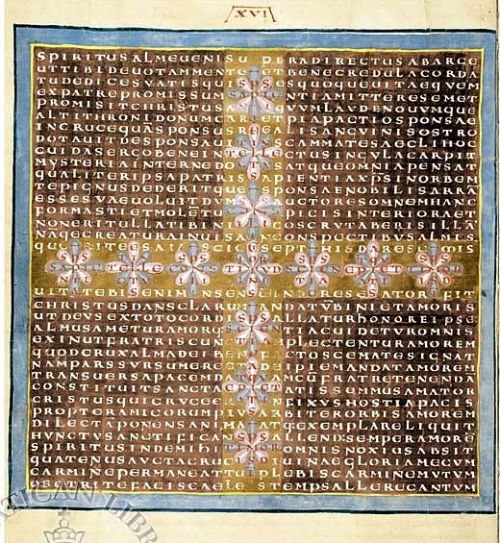
One of Raban's teaching aids for his students.
Writing became his life.
Raban's works were collected and published in 1842 and among them was a Life of Mary Magdalene, which had been discovered in the college of Mary Magdalene at Oxford. This proved that the cult of Mary Magdalene was known everywhere and not just in Provence. The original 6th century Lives of the Saints, that Raban Maur updated, has now completely disappeared, but it is known that it existed. A letter of the 7th century from Saint Didier, who was the governer of Marseille and the Bishop of Cahors, confirms it.
Didier had sent a copy of the 6th century Life of Mary Magdalene to the Abbess Aspasie to whom he had written; "Moved by your tears, I have found for you a history of this remarkable woman in all the Gospels. In this story you will find the dignified fruits of penitence which she produced and the joy which replenished heaven, when she who had been a sinner, deserving her tears, came before the angels of God." This, and stories of other saints, was read aloud at church services, "to the great happiness of the faithful."
Jean Alain Sipra, an unusual Rennes-le-Château writer, says Raban was inspired by the "Vie Primitive de Marie-Madeleine en Provence", a 5th century story known to have existed at the time. ("Primitive" in this sense just means "early.")
Raban said that the story of Mary Magdalene was compiled according to "accounts that our fathers have left us in their writings." He also said he had added "spoken legends" to enrich it. Raban Maur starts ordinarily; Mary Magdalene arrived, in the company of Maximin, in the country of Aix. But after Mary died, the story becomes astonishing; The Bishop Maximin, taking her very holy corpse, enbalmed it with various ointments and placed it in an well-credited mausoleum and built over these blissful remains, a basilic of beautiful architecture. This basilica became with time so sacred that neither king or prince or anyone distinguished according to the pomp of the century, dared to enter this church, there to solicit grace, without leaving outside his arms and being stripped of all sentiments of brutal ferocity.
The translator, Faillon, of Maur's text in 1842 added a footnote; it must not be heard that these were princes of Carolingian times, but the Visigothic and Burgundian kings. Faillon knew Raban's version had been taken from the earlier 5th century one; and Rennes-le-Château was founded by the Visigoths around 414AD. The Visigoths were not in Provence until around 480AD.
This fascinated me, because Jean Alain Sipra, an architect who lived for a long time at Rennes-le-Château, was intrigued by this description of a mausoleum because no building of that description was built in Aix at the time; but Sipra had discovered, in an aerial photograph, the outline of such a building on the level plain just below the citadel of Rennes-le-Château. Could Mary Magdalene have been buried there? If so, Sipra understood the coded message; it was the Visigothic kings of Rennes-le-Château who had to leave their brutality outside when they stepped into her basilica.
Jean Alain Sipra thought this "martyrium" between Rennes-le-Château and Rennes-les-Bains could have contained the graves of Mary Magdalene and St. Paul Serge of Narbonne. (I don't . . . ) He also says that Raban Maur thinks that Mary met Paul Serge in Cyprus in 45AD, then the two travelled to Narbonne and then to Rennes-les-Bains. I have also heard this story from other people. Paul Serge is Sergius Paulus, mentioned in Acts, 13, 7., who was converted by Paul.
There are certainly many legends in Narbonne associating Mary Magdalene with St. Paul Serge. There is no evidence Paul travelled with Mary Magdalene, but the fact that Raban believed he did is amazing. The link beween Narbonne, Mary Magdalene and Paul Serge existed in the 5th century, and it exists now. Paul Serge was in Narbonne from about 50AD, that is a fact of Narbonne history.
Click here for my article about St. Paul Serge.
Wikipedia says about Raban's Life of Mary Magdalene; It includes the related sections of our Lord's life and the legendary history of the sisters, and is in its way an interesting work. But Raban confounds Mary the sister of Lazarus with Mary of Magdala. Hence after declaring that Mary was a miracle of beauty Raban is obliged to touch upon her unchastity prior to her meeting with Christ. It is only recently that the church has decided Mary Magdalene and Mary of Bethany are the same person but Raban Maur believed it in the 9th century. He was ahead of his time.
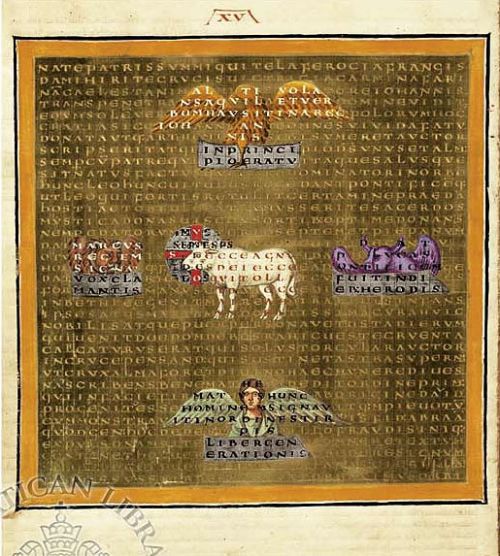 This picture represents the Lamb of God with the four apostles
This picture represents the Lamb of God with the four apostles
Other Raban Writings
Raban Maur also re-wrote the 5th century version by the monk Gildas of the life of Joseph of Arimathea. In Britain, Joseph was greeted kindly by King Arviragus, brother of Caractacus the Pendragon and was granted twelve hides of Glastonbury land; a hide was equivalent to 120 acres, therefore the 12 hides were 1440 acres. He constructed a wattle-and-daub building for use as a church, maybe for his workers; it's unlikely Joseph would have negotiated all this without business interests in mind, for even in 1086, said the Domesday Book, the Glastonbury land and church had never paid tax.
Gildas had called Joseph of Arimathea a "noble decurio", Raban Maur, who wrote in the 8th century, called him a "noblis decurion". A decurio was an overseer of mining estates and the term originated in Spain, where Jewish metalworkers had been operative in the celebrated foundries of Toledo since the 6th century BC. Tin was essential for the production of bronze and the most important tin mines in the Roman Empire were in south western England, an area rich also in copper and lead, for which there was a great market in the expanding Empire.
This is amazing, for it is historical fact that reinforces the stories of Joseph of Arithmathea at Glastonbury, but also reinforces Joseph's high position among the Romans of the time and implies that he could have influenced Pontius Pilate enough to take Jesus down from the cross in time to save his life.
Raban wrote a Life of St. Martha, Mary Magdalene's sister, also based on the 5th century "Lives of the Saints" found among the monastery's documents. Martha, went on from Marseille to Tarascon when "The Provençal Saints" arrived in the south of France.
The name Tarascon comes from the Tarasque, a ferocious dragon-monster with a lion's head, spiked backbone and a long serpent tail, which the legend states devoured countless human victims and terrorized the district from its marshy lair, deep in the woods. . . . Saint Martha confronted the fearsome beast in its lair, pacified it and led it on a leash made from her gridle, three times around the walls of Tarascon. The beast was then either locked in a dungeon, or stoned to death, or else drowned in the Rhône. (She slayed the dragon; symbolically, she banished evil.) By this courageous action, Martha managed to convert the entire town to Christianity.
In 1474, Good King René d'Anjou founded the Jeux de la Tarasque, to mark the occasion. Still today, a procession is held the second Sunday after Pentecost, with a home-made monster spouting smoke from its nostrils. On 29th July, St. Martha's day, a week after Mary Magdalene's day, a smaller procession is led round the town on a lead by a local maiden dressed as Martha.
There still exists a 3rd century sarcophage, now part of the façade of the altar in today's church at Tarascon, reputed to be Martha's. The style is typically Roman. Martha worked many miracles. King Clovis came to Tarascon in 500AD and was cured of a kidney disease by touching the tomb of Martha. This miracle was included in Raban Maur's story.
The rest of Raban's life.
In 822 Eigil died and Raban was elected his successor. He took personal interest in the monks, and frequently preached to them. He also added six affiliated monasteries to the sixteen already existing in Fulda.
In the spring of 842 Raban laid down his office and retired to his "cell" to end his days in literary activity undisturbed by the cares of office. He called in the aid of several assistants and so worked rapidly. But he was too valuable a man to be allowed to retire from active life. He was elected archbishop of Mainz and was consecrated on June 26, 847.
He remained a kind man; during the great famine in Germany in 850AD Raban the Archbishop himself fed more than 300 persons daily in the village of Winzel. In October, 851 or 852, Raban presided over a third synod at Mainz, which passed a number of reform canons; such as forbidding the clergy to hunt, and he criticised a layman who withdrew from a priest who had been married, thinking priests must be virgins. Once again, he was ahead of his time.
Raban died, having written his own modest epitaph, at Mainz Feb. 4, 856, and was buried in the monastery there. 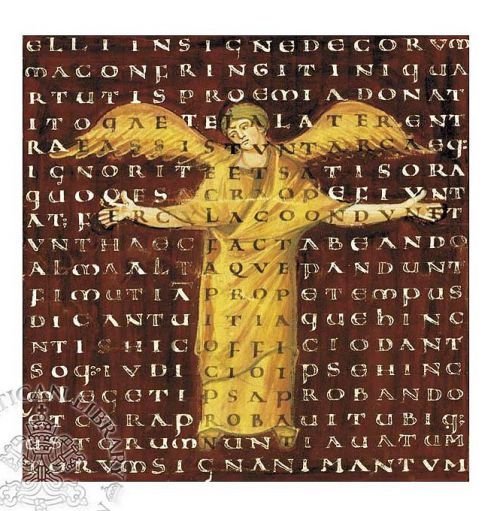
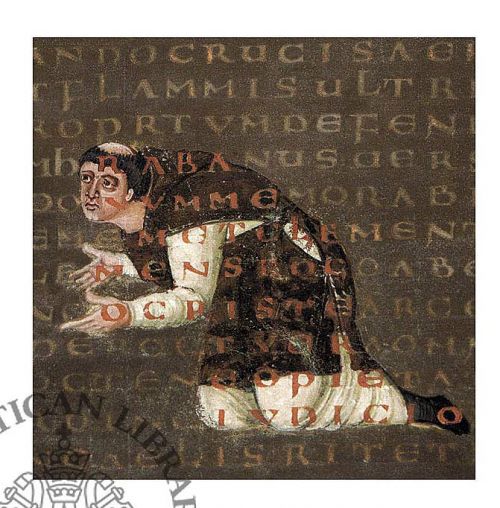
Today Raban is remembered as an educationalist and the founder of the German School System. The pupils of Raban were in demand themselves as teachers. A former pupil who himself became a great scholar and teacher, Einhard, sent his son to Raban with instructions to "attend to what is said by that great orator, Raban Maur." Alcuin was Raban's model, Raban enlarged Alcuin's conception of education, and in himself and his works set an example whose influence has never been lost.
Raban was a voluminous author. He was quick to respond to the needs of his day, and to answer questions of enquiring students.
It appears that the Biblical books he taught from were separate and not part of one Bible, as today. Frechulf, bishop of Lisieux, in urging Raban to comment on the Pentateuch, states that in his diocese there were very few books of any kind, not even a whole Bible.
Raban's commentaries contain a great deal of mystical and spiritual interpretation. The labour in their composition must have been considerable, but he carried it on for twenty years. He did not always copy the exact language of his sources, but reproduced it in his own words.
He wrote about church ceremonies with many instructions to priests. The priest is to come forth as God's spokesman, and if he is truly a man of God he will be upheld by divine power. This is the proper spirit. Man is nothing. God is everything.
In later years he wrote a whole encyclopedia called The Universe, covering such subjects as man himself, the beasts, the starry heavens, time and the divisions of time, the waters on and under the earth, the clouds above it, and the earth itself. He speaks of mountains and valleys and divers places; of public buildings and their parts; of philosophy and linguistics, stones and metals, weights and measures, diseases and remedies, trees and plants, wars and triumphs, shows and games, pictures and colors, dress and ornaments, food and drink, vehicles and harness.
He wrote something that Henri Boudet of Rennes-les-Bains would have loved - The invention of languages - a curious collection of alphabets—Hebrew, Greek, Latin, Scythian and Runic, with the names of the supposed inventors.
He wrote about the magic arts! Raban was singularly free from the superstitions of his time, for in the second part of this tract, written in 842, he takes strong ground against necromancy in all its forms, of which he gives an interesting catalogue, and while explaining the appearance of ghosts, evil spirits and similar supposed existences on the ground of demoniac influence, he yet admits the possibility that the senses may be deceived. Very open-minded.
His most extraordinary production is a long poem, "The praise of the Cross." This was begun at the suggestion of Alcuin. Raban presents twenty-eight drawings by his friend Hatto. Some are geometrical, others are of persons or objects. The words of his poems were arranged in squares of 36 lines each with 36 letters, in front of a picture that told the story. The letters are regularly spaced and some are purposely arranged in prominent and peculiar positions so that they catch the eye and form other words.
Raban wanted poor people to understand the words of the Bible teachings. This completely new art form is still artistically stunning. The concept is so modern - you could hang them in an art gallery today. Beautiful!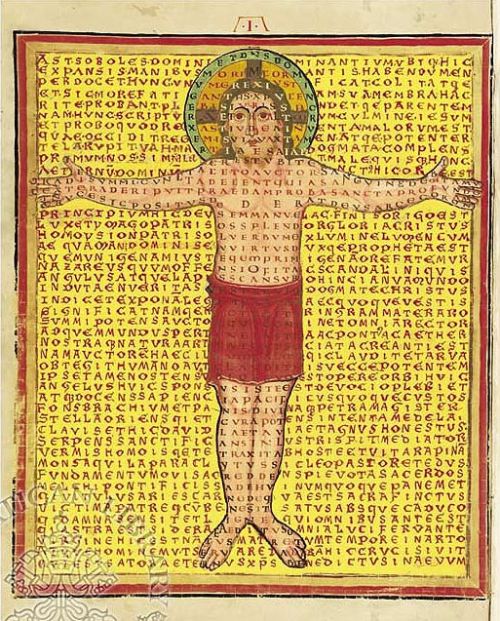
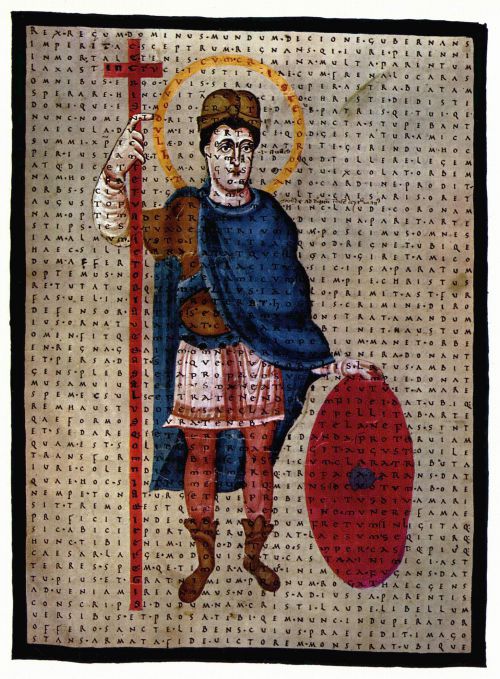
Inscrivez-vous au site
Soyez prévenu par email des prochaines mises à jour
Rejoignez les 261 autres membres

